FinancialBroker - MDI application with EF code first database.
1.Database.
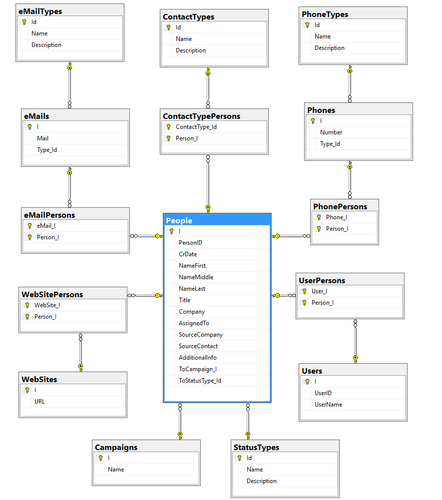
In this page I describe start of one my interesting project. This project is huge, and this is only a start. First point is database. This is my first project I try to use EF Code First technology with deploy and migration to MS SQL server. In this project I use relation M:1. 1:M, 1:1 and M:M Визначення зв'язків даних 1:1, 1:M, M:M у базі та EF CodeFirst..
I try to describe CRUD pattern around one entity of this project - Person.
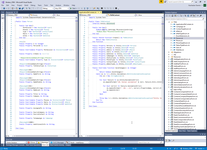
This is main class of definition Person.
1: Imports System.ComponentModel.DataAnnotations
2:
3: Public Class Person
4:
5: Public Sub New()
6: Permission = New HashSet(Of User)
7: Phones = New HashSet(Of Phone)
8: Type = New HashSet(Of ContactType)
9: Mails = New HashSet(Of eMail)
10: Sites = New HashSet(Of WebSite)
11: End Sub
12:
13: <Key()>
14: Public Property I As Integer
15: Public Property PersonID As Guid
16:
17: Public Overridable Property Permission As ICollection(Of User)
18:
19: Public Property CrDate As DateTime
20:
21: '<Required(AllowEmptyStrings:=False)>
22: Public Overridable Property Type As ICollection(Of ContactType)
23:
24: <Required(AllowEmptyStrings:=False)>
25: Public Property ToStatusType As StatusType
26:
27: <MaxLength(50)>
28: <Required(AllowEmptyStrings:=False)>
29: Public Property NameFirst As String
30:
31: <MaxLength(50)>
32: <Required(AllowEmptyStrings:=False)>
33: Public Property NameMiddle As String
34:
35: <MaxLength(50)>
36: <Required(AllowEmptyStrings:=False)>
37: Public Property NameLast As String
38:
39: Public Property Title As String
40: Public Property Company As String
41:
42: Public Overridable Property Phones As ICollection(Of Phone)
43: Public Overridable Property Mails As ICollection(Of eMail)
44: Public Overridable Property Sites As ICollection(Of WebSite)
45:
46: Public Property AssignedTo As String
47:
48: Public Property SourceCompany As String
49: Public Property SourceContact As String
50:
51: Public Property ToCampaign As Campaign
52:
53: <MaxLength(1000)>
54: Public Property AdditionalInfo As String
55:
56: End Class
Person has relation M:1 to Campaign and StatusType.
1: Imports System.ComponentModel.DataAnnotations
2: Public Class Campaign
3:
4: Public Sub New()
5:
6: End Sub
7:
8: <Key()>
9: Public Property I As Integer
10: <MaxLength(50)>
11: Public Property Name As String
12:
13: Public Overridable Property Persons As ICollection(Of Person) = New HashSet(Of Person)
14:
15: End Class
1: Imports System.ComponentModel.DataAnnotations
2: Imports System.ComponentModel.DataAnnotations.Schema
3:
4: Public Enum StatusTypeEnum
5: Lead = 1
6: Assigned = 2
7: Active = 3
8: Declined = 4
9: End Enum
10:
11: Public Class StatusType
12:
13: Public Sub New()
14:
15: End Sub
16:
17: Public Sub New(ByVal [Enum] As StatusTypeEnum)
18: Id = CInt([Enum])
19: Name = [Enum].ToString()
20: End Sub
21:
22: <Key, DatabaseGenerated(DatabaseGeneratedOption.None)>
23: Public Property Id As Integer
24:
25: <Required, MaxLength(100)>
26: Public Property Name As String
27:
28: <MaxLength(100)>
29: Public Property Description As String
30:
31: End Class
StatusType is not simple. It has interesting opportunities - it based on ENUM and ENUM type is sort out during database initialization (SEED) and StatusType catalog is fills by data.
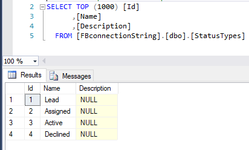
This is a code of SEED method with enumeration ENUM definition.
1: Imports System
2: Imports System.Data.Entity
3: Imports System.Data.Entity.Migrations
4: Imports System.Linq
5:
6: Namespace Migrations
7:
8: Friend NotInheritable Class Configuration
9: Inherits DbMigrationsConfiguration(Of FbDbContext)
10:
11: Public Sub New()
12: AutomaticMigrationsEnabled = False
13: End Sub
14:
15: Protected Overrides Sub Seed(context As FbDbContext)
16:
17: For Each One As StatusTypeEnum In System.Enum.GetValues(GetType(StatusTypeEnum))
18: context.StatusTypes.AddOrUpdate(New StatusType(One))
19: Next
20: For Each One As ContactTypeEnum In System.Enum.GetValues(GetType(ContactTypeEnum))
21: context.ContactTypes.AddOrUpdate(New ContactType(One))
22: Next
23: For Each One As eMailTypeEnum In System.Enum.GetValues(GetType(eMailTypeEnum))
24: context.eMailTypes.AddOrUpdate(New eMailType(One))
25: Next
26: For Each One As PhoneTypeEnum In System.Enum.GetValues(GetType(PhoneTypeEnum))
27: context.PhoneTypes.AddOrUpdate(New PhoneType(One))
28: Next
29: context.Users.Add(New User With {.UserName = "all", .UserID = Guid.Parse("00000000-0000-0000-0000-000000000001")})
30: context.SaveChanges()
31: End Sub
32:
33:
34: End Class
35:
36: End Namespace
Also this data structure has five M:M relation to another type - Permission, Type, Phones, Mails, Sites.
1: Imports System.ComponentModel.DataAnnotations
2: Public Class User
3:
4: Public Sub New()
5: ToPerson = New HashSet(Of Person)
6: End Sub
7:
8: <Key()>
9: Public Property I As Integer
10:
11: Public Property UserID As Guid
12:
13: <MaxLength(50)>
14: Public Property UserName As String
15:
16: Public Overridable Property ToPerson As ICollection(Of Person)
17:
18: End Class
1: Imports System.ComponentModel.DataAnnotations
2: Imports System.ComponentModel.DataAnnotations.Schema
3:
4: Public Enum ContactTypeEnum
5: Funder = 1
6: Broker = 2
7: Merchant = 3
8: Collector = 4
9: CreditCardProcessor = 5
10: Vendor = 6
11: Investor = 7
12: General = 8
13: Other = 9
14: End Enum
15:
16:
17: Public Class ContactType
18:
19: Public Sub New()
20: ToPerson = New HashSet(Of Person)
21: End Sub
22:
23: Public Sub New(ByVal [Enum] As ContactTypeEnum)
24: Id = CInt([Enum])
25: Name = [Enum].ToString()
26: ToPerson = New HashSet(Of Person)
27: End Sub
28:
29: <Key, DatabaseGenerated(DatabaseGeneratedOption.None)>
30: Public Property Id As Integer
31:
32: <Required, MaxLength(100)>
33: Public Property Name As String
34:
35: <MaxLength(100)>
36: Public Property Description As String
37:
38: Public Overridable Property ToPerson As ICollection(Of Person)
39:
40: End Class
1: Imports System.ComponentModel.DataAnnotations
2: Public Class Phone
3:
4: Public Sub New()
5: ToPerson = New HashSet(Of Person)
6: End Sub
7:
8: <Key()>
9: Public Property I As Integer
10:
11: Public Property Type As PhoneType
12:
13: <MaxLength(50)>
14: Public Property Number As String
15:
16: Public Overridable Property ToPerson As ICollection(Of Person)
17:
18: End Class
1: Imports System.ComponentModel.DataAnnotations
2:
3: Public Class eMail
4:
5: Public Sub New()
6: ToPerson = New HashSet(Of Person)
7: End Sub
8:
9: <Key()>
10: Public Property I As Integer
11:
12: Public Property Type As eMailType
13:
14: <MaxLength(50)>
15: Public Property Mail As String
16:
17: Public Overridable Property ToPerson As ICollection(Of Person)
18:
19: End Class
1: Imports System.ComponentModel.DataAnnotations
2: Public Class WebSite
3:
4: Public Sub New()
5: ToPerson = New HashSet(Of Person)
6: End Sub
7:
8: <Key()>
9: Public Property I As Integer
10:
11: <MaxLength(50)>
12: Public Property URL As String
13:
14: Public Overridable Property ToPerson As ICollection(Of Person)
15:
16: End Class
And Mail and Phones has own catalogue types - eMailTypeEnum and PhoneTypeEnum with relation M:1.
1: Imports System.ComponentModel.DataAnnotations
2: Imports System.ComponentModel.DataAnnotations.Schema
3:
4: Public Enum eMailTypeEnum
5: Business = 1
6: Privates = 2
7: End Enum
8:
9: Public Class eMailType
10:
11: Public Sub New()
12:
13: End Sub
14:
15: Public Sub New(ByVal [Enum] As eMailTypeEnum)
16: Id = CInt([Enum])
17: Name = [Enum].ToString()
18: End Sub
19:
20: <Key, DatabaseGenerated(DatabaseGeneratedOption.None)>
21: Public Property Id As Integer
22:
23: <Required, MaxLength(100)>
24: Public Property Name As String
25:
26: <MaxLength(100)>
27: Public Property Description As String
28:
29: Public Overridable Property eMails As ICollection(Of eMail) = New HashSet(Of eMail)
30:
31: End Class
1: Imports System.ComponentModel.DataAnnotations
2: Imports System.ComponentModel.DataAnnotations.Schema
3:
4: Public Enum PhoneTypeEnum
5: Mobile = 1
6: Home = 2
7: Work = 3
8: Fax = 4
9: End Enum
10:
11:
12: Public Class PhoneType
13:
14: Public Sub New()
15:
16: End Sub
17:
18: Public Sub New(ByVal [Enum] As PhoneTypeEnum)
19: Id = CInt([Enum])
20: Name = [Enum].ToString()
21: End Sub
22:
23: <Key, DatabaseGenerated(DatabaseGeneratedOption.None)>
24: Public Property Id As Integer
25:
26: <Required, MaxLength(100)>
27: Public Property Name As String
28:
29: <MaxLength(100)>
30: Public Property Description As String
31:
32: End Class
This is all around Person entity, except fluent API code, generated to deployment this class to DB.
1: Imports System
2: Imports System.Data.Entity.Migrations
3: Imports Microsoft.VisualBasic
4:
5: Namespace Migrations
6: Public Partial Class _1
7: Inherits DbMigration
8:
9: Public Overrides Sub Up()
10: CreateTable(
11: "dbo.Campaigns",
12: Function(c) New With
13: {
14: .I = c.Int(nullable := False, identity := True),
15: .Name = c.String(maxLength := 50)
16: }) _
17: .PrimaryKey(Function(t) t.I)
18:
19: CreateTable(
20: "dbo.People",
21: Function(c) New With
22: {
23: .I = c.Int(nullable := False, identity := True),
24: .PersonID = c.Guid(nullable := False),
25: .CrDate = c.DateTime(nullable := False),
26: .NameFirst = c.String(nullable := False, maxLength := 50),
27: .NameMiddle = c.String(nullable := False, maxLength := 50),
28: .NameLast = c.String(nullable := False, maxLength := 50),
29: .Title = c.String(),
30: .Company = c.String(),
31: .AssignedTo = c.String(),
32: .SourceCompany = c.String(),
33: .SourceContact = c.String(),
34: .AdditionalInfo = c.String(maxLength := 1000),
35: .ToCampaign_I = c.Int(),
36: .ToStatusType_Id = c.Int(nullable := False)
37: }) _
38: .PrimaryKey(Function(t) t.I) _
39: .ForeignKey("dbo.Campaigns", Function(t) t.ToCampaign_I) _
40: .ForeignKey("dbo.StatusTypes", Function(t) t.ToStatusType_Id, cascadeDelete := True) _
41: .Index(Function(t) t.ToCampaign_I) _
42: .Index(Function(t) t.ToStatusType_Id)
43:
44: CreateTable(
45: "dbo.eMails",
46: Function(c) New With
47: {
48: .I = c.Int(nullable := False, identity := True),
49: .Mail = c.String(maxLength := 50),
50: .Type_Id = c.Int()
51: }) _
52: .PrimaryKey(Function(t) t.I) _
53: .ForeignKey("dbo.eMailTypes", Function(t) t.Type_Id) _
54: .Index(Function(t) t.Type_Id)
55:
56: CreateTable(
57: "dbo.eMailTypes",
58: Function(c) New With
59: {
60: .Id = c.Int(nullable := False),
61: .Name = c.String(nullable := False, maxLength := 100),
62: .Description = c.String(maxLength := 100)
63: }) _
64: .PrimaryKey(Function(t) t.Id)
65:
66: CreateTable(
67: "dbo.Users",
68: Function(c) New With
69: {
70: .I = c.Int(nullable := False, identity := True),
71: .UserID = c.Guid(nullable := False),
72: .UserName = c.String(maxLength := 50)
73: }) _
74: .PrimaryKey(Function(t) t.I)
75:
76: CreateTable(
77: "dbo.Phones",
78: Function(c) New With
79: {
80: .I = c.Int(nullable := False, identity := True),
81: .Number = c.String(maxLength := 50),
82: .Type_Id = c.Int()
83: }) _
84: .PrimaryKey(Function(t) t.I) _
85: .ForeignKey("dbo.PhoneTypes", Function(t) t.Type_Id) _
86: .Index(Function(t) t.Type_Id)
87:
88: CreateTable(
89: "dbo.PhoneTypes",
90: Function(c) New With
91: {
92: .Id = c.Int(nullable := False),
93: .Name = c.String(nullable := False, maxLength := 100),
94: .Description = c.String(maxLength := 100)
95: }) _
96: .PrimaryKey(Function(t) t.Id)
97:
98: CreateTable(
99: "dbo.WebSites",
100: Function(c) New With
101: {
102: .I = c.Int(nullable := False, identity := True),
103: .URL = c.String(maxLength := 50)
104: }) _
105: .PrimaryKey(Function(t) t.I)
106:
107: CreateTable(
108: "dbo.StatusTypes",
109: Function(c) New With
110: {
111: .Id = c.Int(nullable := False),
112: .Name = c.String(nullable := False, maxLength := 100),
113: .Description = c.String(maxLength := 100)
114: }) _
115: .PrimaryKey(Function(t) t.Id)
116:
117: CreateTable(
118: "dbo.ContactTypes",
119: Function(c) New With
120: {
121: .Id = c.Int(nullable := False),
122: .Name = c.String(nullable := False, maxLength := 100),
123: .Description = c.String(maxLength := 100)
124: }) _
125: .PrimaryKey(Function(t) t.Id)
126:
127: CreateTable(
128: "dbo.eMailPersons",
129: Function(c) New With
130: {
131: .eMail_I = c.Int(nullable := False),
132: .Person_I = c.Int(nullable := False)
133: }) _
134: .PrimaryKey(Function(t) New With { t.eMail_I, t.Person_I }) _
135: .ForeignKey("dbo.eMails", Function(t) t.eMail_I, cascadeDelete := True) _
136: .ForeignKey("dbo.People", Function(t) t.Person_I, cascadeDelete := True) _
137: .Index(Function(t) t.eMail_I) _
138: .Index(Function(t) t.Person_I)
139:
140: CreateTable(
141: "dbo.UserPersons",
142: Function(c) New With
143: {
144: .User_I = c.Int(nullable := False),
145: .Person_I = c.Int(nullable := False)
146: }) _
147: .PrimaryKey(Function(t) New With { t.User_I, t.Person_I }) _
148: .ForeignKey("dbo.Users", Function(t) t.User_I, cascadeDelete := True) _
149: .ForeignKey("dbo.People", Function(t) t.Person_I, cascadeDelete := True) _
150: .Index(Function(t) t.User_I) _
151: .Index(Function(t) t.Person_I)
152:
153: CreateTable(
154: "dbo.PhonePersons",
155: Function(c) New With
156: {
157: .Phone_I = c.Int(nullable := False),
158: .Person_I = c.Int(nullable := False)
159: }) _
160: .PrimaryKey(Function(t) New With { t.Phone_I, t.Person_I }) _
161: .ForeignKey("dbo.Phones", Function(t) t.Phone_I, cascadeDelete := True) _
162: .ForeignKey("dbo.People", Function(t) t.Person_I, cascadeDelete := True) _
163: .Index(Function(t) t.Phone_I) _
164: .Index(Function(t) t.Person_I)
165:
166: CreateTable(
167: "dbo.WebSitePersons",
168: Function(c) New With
169: {
170: .WebSite_I = c.Int(nullable := False),
171: .Person_I = c.Int(nullable := False)
172: }) _
173: .PrimaryKey(Function(t) New With { t.WebSite_I, t.Person_I }) _
174: .ForeignKey("dbo.WebSites", Function(t) t.WebSite_I, cascadeDelete := True) _
175: .ForeignKey("dbo.People", Function(t) t.Person_I, cascadeDelete := True) _
176: .Index(Function(t) t.WebSite_I) _
177: .Index(Function(t) t.Person_I)
178:
179: CreateTable(
180: "dbo.ContactTypePersons",
181: Function(c) New With
182: {
183: .ContactType_Id = c.Int(nullable := False),
184: .Person_I = c.Int(nullable := False)
185: }) _
186: .PrimaryKey(Function(t) New With { t.ContactType_Id, t.Person_I }) _
187: .ForeignKey("dbo.ContactTypes", Function(t) t.ContactType_Id, cascadeDelete := True) _
188: .ForeignKey("dbo.People", Function(t) t.Person_I, cascadeDelete := True) _
189: .Index(Function(t) t.ContactType_Id) _
190: .Index(Function(t) t.Person_I)
191:
192: End Sub
193:
194: Public Overrides Sub Down()
195: DropForeignKey("dbo.ContactTypePersons", "Person_I", "dbo.People")
196: DropForeignKey("dbo.ContactTypePersons", "ContactType_Id", "dbo.ContactTypes")
197: DropForeignKey("dbo.People", "ToStatusType_Id", "dbo.StatusTypes")
198: DropForeignKey("dbo.People", "ToCampaign_I", "dbo.Campaigns")
199: DropForeignKey("dbo.WebSitePersons", "Person_I", "dbo.People")
200: DropForeignKey("dbo.WebSitePersons", "WebSite_I", "dbo.WebSites")
201: DropForeignKey("dbo.Phones", "Type_Id", "dbo.PhoneTypes")
202: DropForeignKey("dbo.PhonePersons", "Person_I", "dbo.People")
203: DropForeignKey("dbo.PhonePersons", "Phone_I", "dbo.Phones")
204: DropForeignKey("dbo.UserPersons", "Person_I", "dbo.People")
205: DropForeignKey("dbo.UserPersons", "User_I", "dbo.Users")
206: DropForeignKey("dbo.eMails", "Type_Id", "dbo.eMailTypes")
207: DropForeignKey("dbo.eMailPersons", "Person_I", "dbo.People")
208: DropForeignKey("dbo.eMailPersons", "eMail_I", "dbo.eMails")
209: DropIndex("dbo.ContactTypePersons", New String() { "Person_I" })
210: DropIndex("dbo.ContactTypePersons", New String() { "ContactType_Id" })
211: DropIndex("dbo.WebSitePersons", New String() { "Person_I" })
212: DropIndex("dbo.WebSitePersons", New String() { "WebSite_I" })
213: DropIndex("dbo.PhonePersons", New String() { "Person_I" })
214: DropIndex("dbo.PhonePersons", New String() { "Phone_I" })
215: DropIndex("dbo.UserPersons", New String() { "Person_I" })
216: DropIndex("dbo.UserPersons", New String() { "User_I" })
217: DropIndex("dbo.eMailPersons", New String() { "Person_I" })
218: DropIndex("dbo.eMailPersons", New String() { "eMail_I" })
219: DropIndex("dbo.Phones", New String() { "Type_Id" })
220: DropIndex("dbo.eMails", New String() { "Type_Id" })
221: DropIndex("dbo.People", New String() { "ToStatusType_Id" })
222: DropIndex("dbo.People", New String() { "ToCampaign_I" })
223: DropTable("dbo.ContactTypePersons")
224: DropTable("dbo.WebSitePersons")
225: DropTable("dbo.PhonePersons")
226: DropTable("dbo.UserPersons")
227: DropTable("dbo.eMailPersons")
228: DropTable("dbo.ContactTypes")
229: DropTable("dbo.StatusTypes")
230: DropTable("dbo.WebSites")
231: DropTable("dbo.PhoneTypes")
232: DropTable("dbo.Phones")
233: DropTable("dbo.Users")
234: DropTable("dbo.eMailTypes")
235: DropTable("dbo.eMails")
236: DropTable("dbo.People")
237: DropTable("dbo.Campaigns")
238: End Sub
239: End Class
240: End Namespace
2. MDI Form control.
This is conception of MDI-form MDI.avi. This is main form code fragment.
1: Imports System.Windows.Forms
2:
3: Partial Public Class MainMDI
4:
5: Public AddApplicationForm1 As AddApplicationForm
6: Public AddCompanyForm1 As AddCompanyForm
7: Public AddDealToolForm1 As AddDealToolForm
8: Public AddLeadForm1 As AddLeadForm
9: Public AddPersonForm1 As AddPersonForm
...
49: Public ReportHistoryForm1 As ReportHistoryForm
50: Public ReportsDefaultForm1 As ReportsDefaultForm
51: Public ReportsForm1 As ReportsForm
52: Public ReportsPerformanceForm1 As ReportsPerformanceForm
53: Public ReportsPipelineForm1 As ReportsPipelineForm
54: Public ReportsPortfolioForm1 As ReportsPortfolioForm
55: Public ReportsRenewalForm1 As ReportsRenewalForm
56: Public ReportsRepaidForm1 As ReportsRepaidForm
57: Public ReportsRepaymentForm1 As ReportsRepaymentForm
58: Public ReportsSyndicationForm1 As ReportsSyndicationForm
59:
60: Public WithEvents Timer1 As New Timer
61: Public LoginForm1 As New LoginForm
62:
63: Private Sub MainMDI_Load(sender As Object, e As EventArgs) Handles Me.Load
64: Text &= " (" & My.Application.Info.Version.ToString & ")"
65: Me.WindowState = FormWindowState.Maximized
66: Timer1.Interval = 100
67: Timer1.Start()
68: End Sub
69:
70: Private Sub Timer1_Tick(sender As Object, e As EventArgs) Handles Timer1.Tick
71: Timer1.Stop()
72: LoginForm1.WindowState = FormWindowState.Normal
73: LoginForm1.TopMost = True
74: LoginForm1.StartPosition = FormStartPosition.CenterScreen
75: LoginForm1.ShowDialog()
76: End Sub
77:
78: #Region "Toolbars"
79:
80: Private Sub AddCompanyStripButton_Click(sender As Object, e As EventArgs) Handles AddCompanyStripButton.Click
81: AddCompanyForm_Open()
82: End Sub
83:
84: Private Sub AddPersonToolStripButton_Click(sender As Object, e As EventArgs) Handles AddPersonToolStripButton.Click
85: AddPersonForm_Open()
86: End Sub
87:
88: Private Sub AddApplicationToolStripButton_Click(sender As Object, e As EventArgs) Handles AddApplicationToolStripButton.Click
89: AddApplicationForm_Open()
90: End Sub
91:
92: Private Sub AddDealToolStripButton_Click(sender As Object, e As EventArgs) Handles AddDealToolStripButton.Click
93: AddDealToolForm_Open()
94: End Sub
95:
96: #End Region
97:
98: #Region "Home"
99:
100: Private Sub HomeTaskToolStripMenuItem_Click(sender As Object, e As EventArgs) Handles HomeTaskToolStripMenuItem.Click
101: HomeTaskForm_Open()
102: End Sub
103:
104: Private Sub HomeMyDealsToolStripMenuItem_Click(sender As Object, e As EventArgs) Handles HomeMyDealsToolStripMenuItem.Click
105: HomeMyDealsForm_Open()
106: End Sub
107:
108: Private Sub HomeNotificationToolStripMenuItem_Click(sender As Object, e As EventArgs) Handles HomeNotificationToolStripMenuItem.Click
109: HomeNotificationForm_Open()
110: End Sub
111:
112:
113: #End Region
...
346:
347: #Region "Help"
348:
349: Private Sub HelpContentsToolStripMenuItem_Click(sender As Object, e As EventArgs) Handles HelpContentsToolStripMenuItem.Click
350: HelpContentsForm_Open()
351: End Sub
352:
353: Private Sub HelpIndexToolStripMenuItem_Click(sender As Object, e As EventArgs) Handles HelpIndexToolStripMenuItem.Click
354: HelpIndexForm_Open()
355: End Sub
356:
357: Private Sub HelpSearchToolStripMenuItem_Click(sender As Object, e As EventArgs) Handles HelpSearchToolStripMenuItem.Click
358: HelpSearchForm_Open()
359: End Sub
360:
361: Private Sub HelpAboutToolStripMenuItem_Click(sender As Object, e As EventArgs) Handles HelpAboutToolStripMenuItem.Click
362: HelpAboutForm_Open()
363: End Sub
364:
365:
366: #End Region
367:
368: End Class
Some function I created my own macroprocessor and placed it to second file co continue main form definition file.
1: Partial Public Class MainMDI
2:
3: Public Sub AddApplicationForm_Open()
4: If Not (Me.MdiChildren.Any(Function(X) X Is AddApplicationForm1)) Then
5: AddApplicationForm1 = AddApplicationForm1.OpenAsMDI
6: Else
7: AddApplicationForm1.WindowState = FormWindowState.Normal
8: End If
9: AddApplicationForm1.BringToFront()
10: End Sub
11:
12:
13: Public Sub AddCompanyForm_Open()
14: If Not (Me.MdiChildren.Any(Function(X) X Is AddCompanyForm1)) Then
15: AddCompanyForm1 = AddCompanyForm1.OpenAsMDI
16: Else
17: AddCompanyForm1.WindowState = FormWindowState.Normal
18: End If
19: AddCompanyForm1.BringToFront()
20: End Sub
21:
...
531:
532:
533: Public Sub ReportsSyndicationForm_Open()
534: If Not (Me.MdiChildren.Any(Function(X) X Is ReportsSyndicationForm1)) Then
535: ReportsSyndicationForm1 = ReportsSyndicationForm1.OpenAsMDI
536: Else
537: ReportsSyndicationForm1.WindowState = FormWindowState.Normal
538: End If
539: ReportsSyndicationForm1.BringToFront()
540: End Sub
541:
542:
543:
544: End Class
Third part of MDI-form control is polymorphism extension functions. It also automatically generated by my own macroprocessor.
1: Imports System.Runtime.CompilerServices
2:
3: Module MDIextension1
4:
5: <Extension>
6: Public Function OpenAsMDI(X As AddApplicationForm) As AddApplicationForm
7: OpenAsMDI = New AddApplicationForm
8: OpenAsMDI.MdiParent = MainMDI
9: OpenAsMDI.Show()
10: OpenAsMDI.BringToFront()
11: End Function
12:
13:
14: <Extension>
15: Public Function OpenAsMDI(X As AddCompanyForm) As AddCompanyForm
16: OpenAsMDI = New AddCompanyForm
17: OpenAsMDI.MdiParent = MainMDI
18: OpenAsMDI.Show()
19: OpenAsMDI.BringToFront()
20: End Function
21:
...
481:
482: <Extension>
483: Public Function OpenAsMDI(X As ReportsSyndicationForm) As ReportsSyndicationForm
484: OpenAsMDI = New ReportsSyndicationForm
485: OpenAsMDI.MdiParent = MainMDI
486: OpenAsMDI.Show()
487: OpenAsMDI.BringToFront()
488: End Function
489:
490:
491:
492: End Module
3.CRUD form for Person entity.
This is Add form.
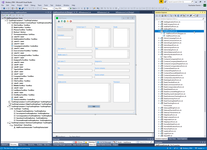
1: Imports Microsoft.VisualBasic
2:
3: Public Class AddPersonForm
4:
5: Dim db1 As New FbDbContext
6:
7: Private Sub AddPersonForm_Load(sender As Object, e As EventArgs) Handles Me.Load
8: Dim A = db1.Campaigns.ToList
9: CampaignsComboBox.DataSource = A
10: CampaignsComboBox.DisplayMember = "Name"
11: Dim S = db1.StatusTypes.ToList
12: StatusComboBox.DataSource = S
13: StatusComboBox.DisplayMember = "Name"
14: Dim P() As String = {"All", My.Settings.UserName1, My.Settings.UserName2}
15: PermissionListView.CheckBoxes = True
16: PermissionListView.View = View.Details
17: PermissionListView.Columns.Add("User", 120, HorizontalAlignment.Left)
18: P.ToList.ForEach(Sub(X) PermissionListView.Items.Add(X))
19: Dim T = db1.ContactTypes.ToList
20: TypeListView.CheckBoxes = True
21: TypeListView.View = View.Details
22: TypeListView.Columns.Add("User", 120, HorizontalAlignment.Left)
23: T.ForEach(Sub(X) TypeListView.Items.Add(X.Name))
24: For Each One As ListViewItem In PermissionListView.Items
25: If One.Text = "All" Then
26: One.Checked = True
27: Exit For
28: End If
29: Next
30: End Sub
31:
32: Dim X As Person
33: Private Sub Button1_Click(sender As Object, e As EventArgs) Handles Button1.Click
34: X = New Person
35: Try
36: With X
37: Dim ListContactType As New List(Of ContactType)
38: For Each One As ListViewItem In TypeListView.Items
39: If One.Checked Then
40: ListContactType.Add(db1.ContactTypes.Where(Function(Q) Q.Name = One.Text).FirstOrDefault)
41: End If
42: Next
43:
44: Dim ListPermission As New List(Of User)
45: For Each One As ListViewItem In PermissionListView.Items
46: If One.Checked Then
47: ListPermission.Add(db1.Users.Where(Function(Q) Q.UserName = One.Text).FirstOrDefault)
48: End If
49: Next
50:
51: If Not String.IsNullOrWhiteSpace(CampaignsComboBox.Text) Then
52: Dim Camp = db1.Campaigns.Add(New Campaign())
53: Camp.Name = CampaignsComboBox.Text
54: .ToCampaign = Camp
55: Else
56: .ToCampaign = Nothing
57: End If
58:
59:
60: Dim ST As String() = SiteTextBox.Text.Split(vbCrLf)
61: Dim ListWebSite As New List(Of WebSite)
62: For Each One In ST
63: If Not String.IsNullOrWhiteSpace(One) Then
64: Dim uriResult As Uri
65: Dim ValidURL As Boolean = Uri.TryCreate(One, UriKind.Absolute, uriResult) AndAlso (uriResult.Scheme = Uri.UriSchemeHttp Or uriResult.Scheme = Uri.UriSchemeHttps)
66: If Not ValidURL Then
67: MsgBox(One & vbCrLf & "is not valis URL")
68: Exit Sub
69: End If
70: ListWebSite.Add(New WebSite With {.URL = One})
71: End If
72: Next
73:
74: Dim PhoneType1 As PhoneType = db1.PhoneTypes.Where(Function(a) a.Id = PhoneTypeEnum.Home).FirstOrDefault
75: Dim PT As String() = PhonesTextBox.Text.Split(vbCrLf)
76: Dim ListPhone As New List(Of Phone)
77: For Each One In PT
78: If Not String.IsNullOrWhiteSpace(One) Then
79: ListPhone.Add(New Phone With {.Number = One, .Type = PhoneType1})
80: End If
81: Next
82:
83: Dim MailType1 As eMailType = db1.eMailTypes.Where(Function(a) a.Id = eMailTypeEnum.Business).FirstOrDefault
84: Dim MT As String() = MailsTextBox.Text.Split(vbCrLf)
85: Dim ListMail As New List(Of eMail)
86: For Each One In MT
87: If Not String.IsNullOrWhiteSpace(One) Then
88: Try
89: Dim M As New Net.Mail.MailAddress(One)
90: Catch ex As FormatException
91: MsgBox(One & vbCrLf & "is not valis eMail")
92: Exit Sub
93: End Try
94: ListMail.Add(New eMail With {.Mail = One})
95: End If
96: Next
97:
98: Dim TT = db1.StatusTypes.Where(Function(A) A.Name = StatusComboBox.Text).FirstOrDefault
99:
100: .PersonID = Guid.NewGuid
101: .CrDate = Now
102: .Type = ListContactType
103: .ToStatusType = TT
104: .NameFirst = FirstNameTextBox.Text
105: .NameMiddle = MiddleTextBox.Text
106: .NameLast = LastNameTextBox.Text
107: .Title = TitleTextBox.Text
108: .Company = CompanyTextBox.Text
109: .Phones = ListPhone
110: .Mails = ListMail
111: .Sites = ListWebSite
112: .AssignedTo = AssignedToTextBox.Text
113: .SourceCompany = SourceCompanyTextBox.Text
114: .SourceContact = SourceContactTextBox.Text
115: .AdditionalInfo = AdditionalInfoTextBox.Text
116: .Permission = ListPermission
117: End With
118: db1.Persons.Add(X)
119: db1.SaveChanges()
120:
121: AddPersonStatusLabel.Text = "Person """ & FirstNameTextBox.Text & " " & MiddleTextBox.Text & " " & LastNameTextBox.Text & """ added, ID=" & Guid.NewGuid.ToString
122: ToolStrip1.Refresh()
123:
124: CampaignsComboBox.Text = ""
125: FirstNameTextBox.Text = ""
126: MiddleTextBox.Text = ""
127: LastNameTextBox.Text = ""
128: TitleTextBox.Text = ""
129: CompanyTextBox.Text = ""
130: AdditionalInfoTextBox.Text = ""
131: PhonesTextBox.Text = ""
132: MailsTextBox.Text = ""
133: SiteTextBox.Text = ""
134: AssignedToTextBox.Text = ""
135: SourceCompanyTextBox.Text = ""
136: SourceContactTextBox.Text = ""
137: For Each One As ListViewItem In TypeListView.Items
138: One.Checked = False
139: Next
140: For Each One As ListViewItem In PermissionListView.Items
141: If One.Text = "All" Then
142: One.Checked = True
143: Else
144: One.Checked = False
145: End If
146: Next
147:
148: Catch ex As Exception
149: MsgBox(ex.Message)
150: db1 = New FbDbContext
151: End Try
152: End Sub
153:
154: Private Sub PeoplesToolStripButton_Click(sender As Object, e As EventArgs) Handles PeoplesToolStripButton.Click
155: MainMDI.ContactsPeoplesForm_Open()
156: End Sub
157:
158: Private Sub SecurityInfoToolStripButton_Click(sender As Object, e As EventArgs) Handles SecurityInfoToolStripButton.Click
159: MainMDI.ContactsSecurityInfoForm_Open()
160: End Sub
161:
162: Private Sub CorrenspondenceToolStripButton_Click(sender As Object, e As EventArgs) Handles CorrenspondenceToolStripButton.Click
163: MainMDI.ContactsCorrespondenceForm_Open()
164: End Sub
165:
166: Private Sub QuestionsToolStripButton_Click(sender As Object, e As EventArgs) Handles QuestionsToolStripButton.Click
167: MainMDI.ContactsQuestionsForm_Open()
168: End Sub
169:
170: Private Sub PersonalDetailsToolStripButton_Click(sender As Object, e As EventArgs) Handles PersonalDetailsToolStripButton.Click
171: MainMDI.ContactsPersonalDetailsForm_Open()
172: End Sub
173: End Class
This is list form to read and delete.
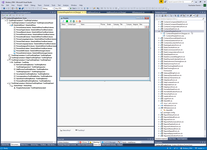
1: Public Class ContactsPeoplesForm
2:
3: Dim db1 As FbDbContext
4: Dim Rows As List(Of Person)
5:
6: Public Enum nColumn
7: Status = 0
8: Type = 1
9: Name = 2
10: Phones = 3
11: Email = 4
12: Campaign = 5
13: Title = 6
14: Company = 7
15: AssignedTo = 8
16: Sites = 9
17: Edit = 10
18: Del = 11
19: End Enum
20:
21: Private Sub ContactsPeoplesForm_Load(sender As Object, e As EventArgs) Handles Me.Load
22: DataGridView1_RowFefresh()
23: End Sub
24:
25: Public Sub DataGridView1_RowFefresh()
26: db1 = New FbDbContext
27: 'db1.Configuration.LazyLoadingEnabled = False
28: Rows = db1.Persons.Include("ToStatusType").Include("ToCampaign").ToList
29: DataGridView1.AutoGenerateColumns = False
30: DataGridView1.DataSource = Rows
31: DataGridView1.Refresh()
32: End Sub
33:
34: Private Sub DataGridView1_CellFormatting(sender As Object, e As DataGridViewCellFormattingEventArgs) Handles DataGridView1.CellFormatting
35: Dim senderGrid = DirectCast(sender, DataGridView)
36: Dim CurCell As DataGridViewCell = senderGrid(e.ColumnIndex, e.RowIndex)
37: If e.ColumnIndex = nColumn.Status Then
38: If Rows(e.RowIndex).ToStatusType IsNot Nothing Then
39: CurCell.Value = Rows(e.RowIndex).ToStatusType.Name
40: End If
41: ElseIf e.ColumnIndex = nColumn.Type Then
42: If Rows(e.RowIndex).Type IsNot Nothing Then
43: Dim Str1 As String = ""
44: For Each One As ContactType In Rows(e.RowIndex).Type
45: Str1 &= One.Name & ","
46: Next
47: CurCell.Value = Str1.TrimEnd(New Char() {","})
48: End If
49: ElseIf e.ColumnIndex = nColumn.Name Then
50: CurCell.Value = Rows(e.RowIndex).NameFirst & " " & Rows(e.RowIndex).NameMiddle & " " & Rows(e.RowIndex).NameLast
51: CurCell.ToolTipText = Rows(e.RowIndex).AdditionalInfo
52: ElseIf e.ColumnIndex = nColumn.Phones Then
53: If Rows(e.RowIndex).Phones IsNot Nothing Then
54: Dim Str1 As String = ""
55: For Each One As Phone In Rows(e.RowIndex).Phones
56: Str1 &= One.Number & ","
57: Next
58: CurCell.Value = Str1.TrimEnd(New Char() {","})
59: End If
60: ElseIf e.ColumnIndex = nColumn.Email Then
61: If Rows(e.RowIndex).Mails IsNot Nothing Then
62: Dim Str1 As String = ""
63: For Each One As eMail In Rows(e.RowIndex).Mails
64: Str1 &= One.Mail & ","
65: Next
66: CurCell.Value = Str1.TrimEnd(New Char() {","})
67: End If
68: ElseIf e.ColumnIndex = nColumn.Campaign Then
69: If Rows(e.RowIndex).ToCampaign IsNot Nothing Then
70: CurCell.Value = Rows(e.RowIndex).ToCampaign.Name
71: End If
72: ElseIf e.ColumnIndex = nColumn.Title Then
73: ElseIf e.ColumnIndex = nColumn.Company Then
74: ElseIf e.ColumnIndex = nColumn.AssignedTo Then
75: ElseIf e.ColumnIndex = nColumn.Sites Then
76: If Rows(e.RowIndex).Sites IsNot Nothing Then
77: Dim Str1 As String = ""
78: For Each One As WebSite In Rows(e.RowIndex).Sites
79: Str1 &= One.URL & ","
80: Next
81: CurCell.Value = Str1.TrimEnd(New Char() {","})
82: End If
83: End If
84: End Sub
85:
86:
87: Private Sub AddPersonToolStripButton_Click(sender As Object, e As EventArgs) Handles AddPersonToolStripButton.Click
88: MainMDI.AddPersonForm_Open()
89: End Sub
90:
91: Private Sub SecurityInfoToolStripButton_Click(sender As Object, e As EventArgs) Handles SecurityInfoToolStripButton.Click
92: MainMDI.ContactsSecurityInfoForm_Open()
93: End Sub
94:
95: Private Sub CorrespondenceToolStripButton_Click(sender As Object, e As EventArgs) Handles CorrespondenceToolStripButton.Click
96: MainMDI.ContactsCorrespondenceForm_Open()
97: End Sub
98:
99: Private Sub QuestionsToolStripButton_Click(sender As Object, e As EventArgs) Handles QuestionsToolStripButton.Click
100: MainMDI.ContactsQuestionsForm_Open()
101: End Sub
102:
103: Private Sub PersonalDetailToolStripButton_Click(sender As Object, e As EventArgs) Handles PersonalDetailToolStripButton.Click
104: MainMDI.ContactsPersonalDetailsForm_Open()
105: End Sub
106:
107: Private Sub DataGridView1_CellContentClick(sender As Object, e As DataGridViewCellEventArgs) Handles DataGridView1.CellContentClick
108: If e.RowIndex >= 0 Then
109: Dim senderGrid = DirectCast(sender, DataGridView)
110: Dim CurRow As Person = Rows(e.RowIndex)
111: If TypeOf senderGrid.Columns(e.ColumnIndex) Is DataGridViewImageColumn AndAlso e.ColumnIndex = nColumn.Edit Then
112: MsgBox("this future under development" & "will be form like 'add person', but for edition contact")
113: ElseIf TypeOf senderGrid.Columns(e.ColumnIndex) Is DataGridViewImageColumn AndAlso e.ColumnIndex = nColumn.Del Then
114: If MsgBox("Do you really want to delete" & CurRow.NameFirst & " " & CurRow.NameMiddle & " " & CurRow.NameLast, MsgBoxStyle.YesNo) = MsgBoxResult.Yes Then
115: db1.Persons.Remove(CurRow)
116: db1.SaveChanges()
117: DataGridView1_RowFefresh()
118: End If
119: End If
120: End If
121: End Sub
122:
123: Private Sub RefreshToolStripButton_Click(sender As Object, e As EventArgs) Handles RefreshToolStripButton.Click
124: db1 = New FbDbContext
125: Rows = db1.Persons.Include("ToStatusType").Include("ToCampaign").ToList
126: DataGridView1.AutoGenerateColumns = False
127: DataGridView1.DataSource = Rows
128: DataGridView1.Refresh()
129: End Sub
130: End Class
to be continue....
 )
)
| <SITEMAP> <MVC> <ASP> <NET> <DATA> <KIOSK> <FLEX> <SQL> <NOTES> <LINUX> <MONO> <FREEWARE> <DOCS> <ENG> <CHAT ME> <ABOUT ME> < THANKS ME> |